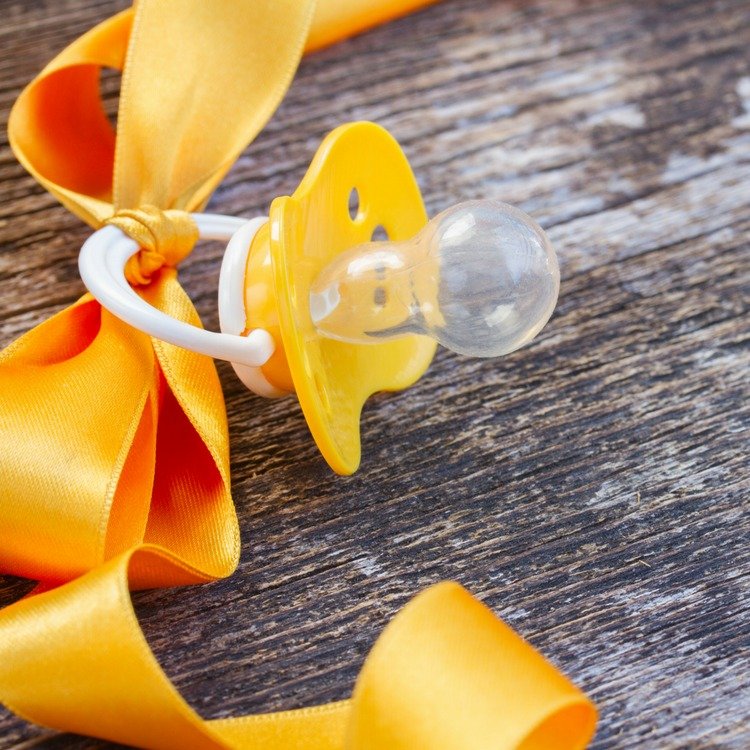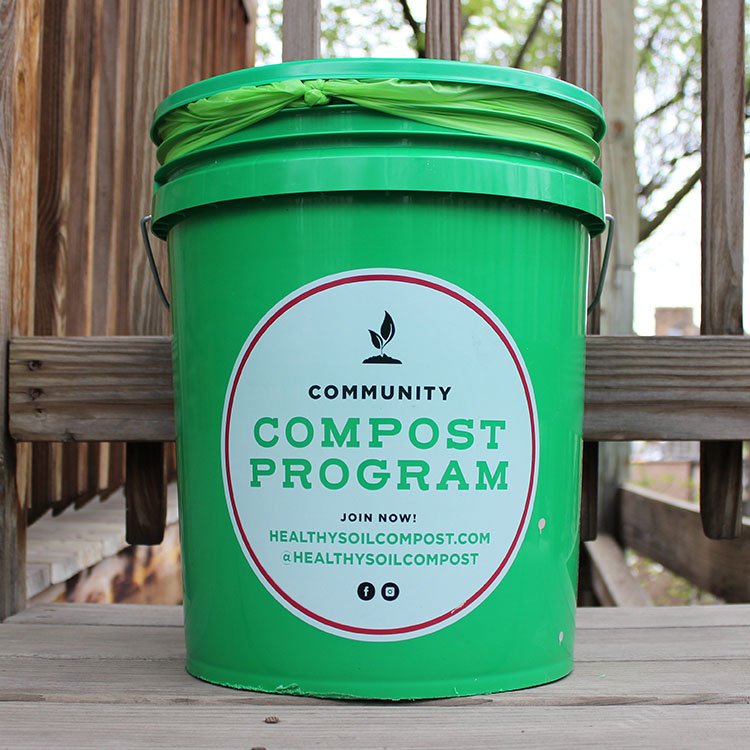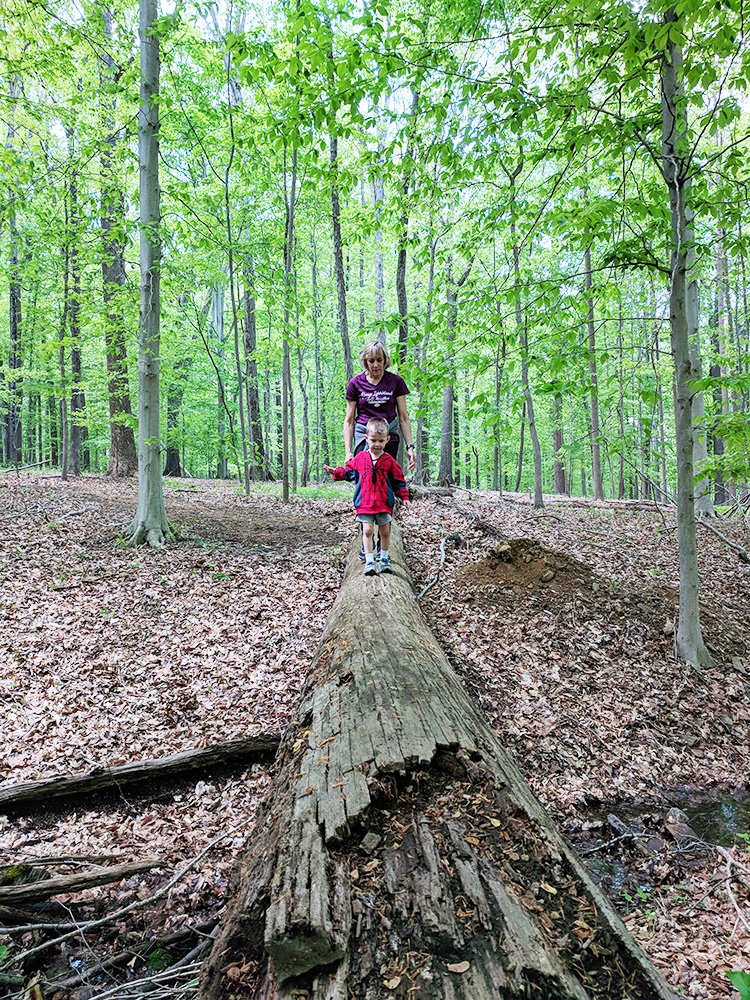How to Start a Sustainability Committee at Your Child’s School: A Step-by-Step Guide + FREE Workbook
Do you ever look at the waste generated at your child’s school and wonder how you can help? Consider starting a sustainability committee or green team at your child’s school to work with school administration and staff.
Through the school sustainability committee, you can implement programs and initiatives to shift the mindset about waste and reduce waste at your child’s school. Read on for details about how to start a sustainability committee at your child’s school based on my experience creating a parent-led green team at my children’s elementary school. And don’t forget to download the free workbook to help you work through the process of starting a sustainability committee.
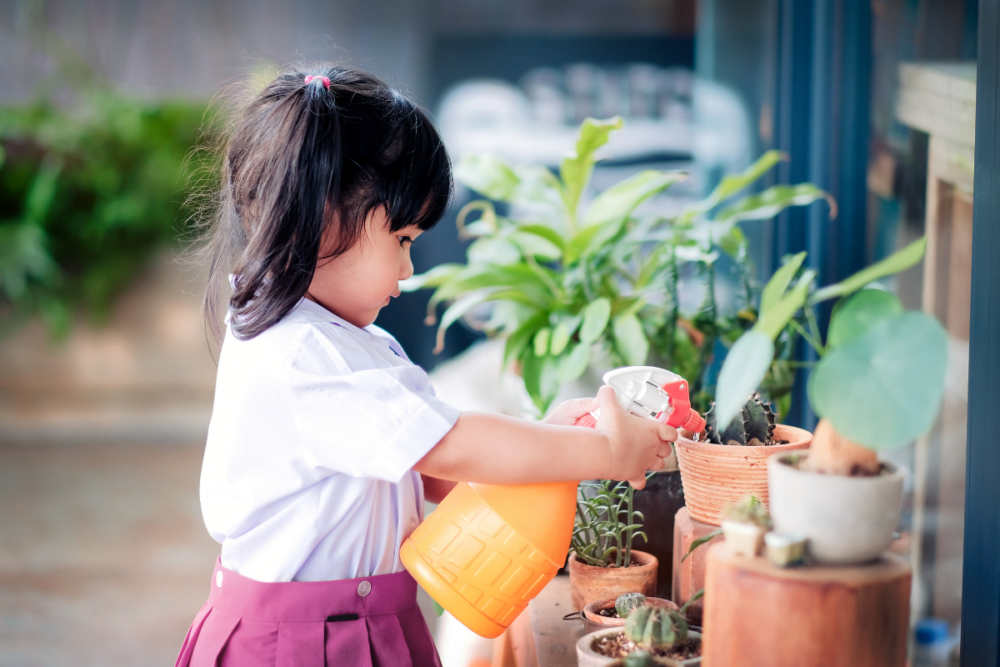
Starting a sustainability committee at your child’s school is a great way to get involved in creating a more environmentally friendly community at their school. By bringing together parents, teachers, and students, you can work together to make a positive impact on the environment. It’s also a great way to teach children the importance of sustainability and help other parents incorporate more sustainable habits into their everyday lives.
As an active advocate of sustainability in my professional and personal lives, I took my skills to school and set out to create a sustainability committee at the school my children attend. While it might seem like a natural transition, it actually took me a couple of years of learning about and getting comfortable with the school before I set about starting the committee.
I’d love to see more sustainability committees in school to help raise awareness about environmental issues and solutions and show students and families a variety of ways to incorporate sustainable living into everyday life. Below, I’ve laid out the steps to start a sustainability committee at school and tips followed by suggestions for success based on my experience over the last several years. I’ve also included a free downloadable workbook to help you walk through the process to start a sustainability committee and your child’s school.
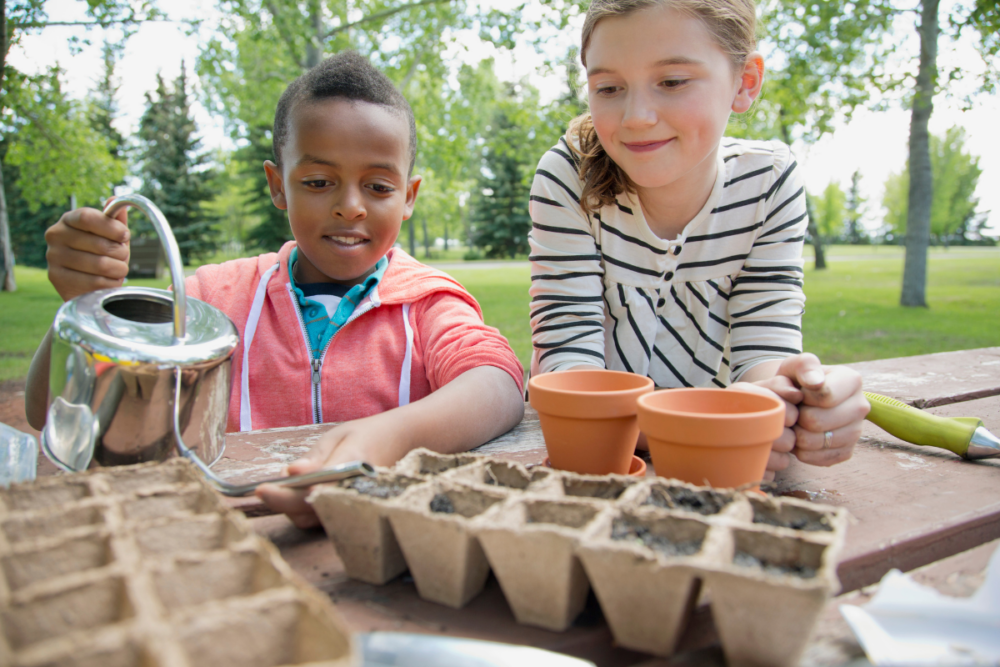
Why Start a Sustainability Committee?
A sustainability committee can help to make changes both big and small, from reducing waste and increasing recycling efforts to implementing energy-saving measures and promoting eco-friendly transportation options. Starting a sustainability committee at your child’s school can have a significant impact on the environment, the school community, and the students. Here are some reasons to start a sustainability committee at your child’s school:
- Reduce the school’s environmental impact | A sustainability committee can help identify areas where the school and families whose children attend the school can reduce waste, conserve energy, and use resources more efficiently. By implementing sustainable practices, the school can reduce its environmental impact and contribute to a healthier planet.
- Engage families in sustainability | A sustainability committee can provide opportunities for students and their families to learn about sustainability and take action to make a difference. By involving students in sustainable practices, the committee can inspire them to become environmental stewards and make sustainable choices in their daily lives.
- Save money | Sustainable practices can often lead to cost savings for the school. For example, reducing energy and water consumption can lower utility bills, while reducing waste can reduce disposal costs and also save money not buying things the school might be able to obtain in other ways. These savings can be reinvested in other areas of the school.
- Earn money for school programs | In some cases, sustainability programs and initiatives can even earn extra money for the school. For example, we host a semi-annual school yard sale, the proceeds from which support the parent-teacher association and the programs funded by that organization.
- Improve the school’s reputation | A sustainability committee can help improve the school’s reputation by demonstrating its commitment to sustainability. This can attract environmentally conscious families to the school and enhance the school’s image in the community.
Overall, starting a sustainability committee can benefit the school, the students, and the environment. By working together to implement sustainable practices, the school community can create a more sustainable future for everyone.

Steps to Start a Sustainability Committee at Your Child’s School
If you’re interested in starting a sustainability committee at your child’s school, there are several steps you can take to get started. It’s important to gather a group of like-minded individuals who are passionate about sustainability and willing to commit to the mission.
From my own experience, I know that starting a school sustainability committee at your child’s school is not complicated, but it does take some time to get started and rally the right advocates for success. Although I had some initial hesitation when my first daughter entered school, the arrival of my second daughter on the school campus (along with two years of prior experience getting to know the school), gave me the confidence to connect with the right people and start a sustainability committee at their school.
My two daughters, now 8 and 10 years old, (3rd and 5th grade) attend our neighborhood public elementary school with about 500-600 other students. We have a super active PTA (parent-teacher association) that is open to ideas to make the school and students’ experience better. For example, we have a garden and a garden educator that are fully funded by the PTA. This type of PTA helped make it easier for me to start the sustainability committee, but it’s certainly not required.
If you’d like to start a sustainability committee at your child’s school, here are some tips and suggestions (based in part on my own experience) to help bring sustainability top-of-mind at your local school.
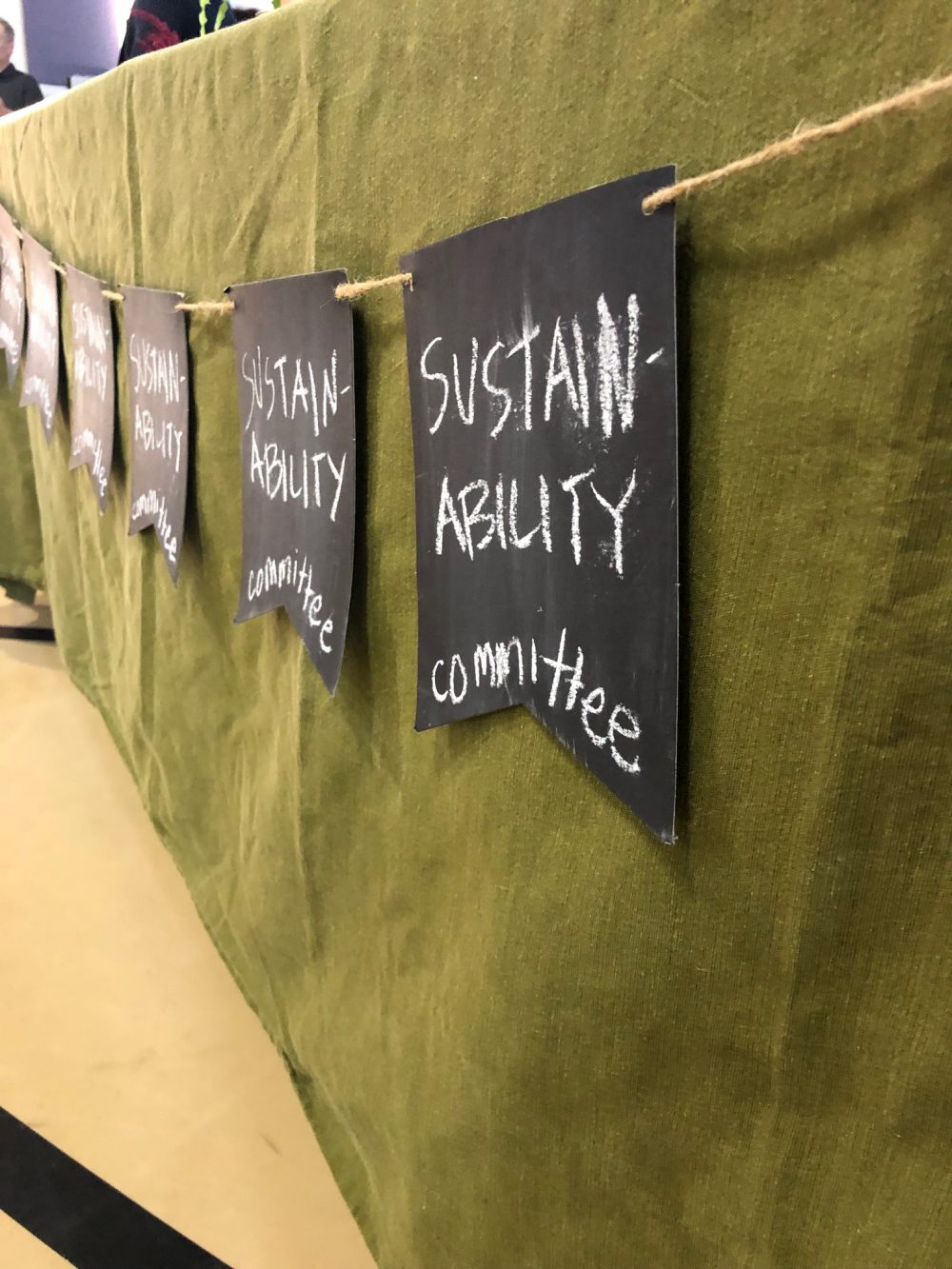
1. Take Time To Learn about the School Environment and Employees Before Getting Started
As with most things in life, change is hard. It’s also often easier to propel change in a community through relationships and consensus building. If you’re looking to start a sustainability committee at your child’s school, first spend some time getting to know the school community: the PTA, the principal, the teachers and aides, the custodians, and the maintenance staff.
The people who work for and volunteer with the school will be responsible for implementing many changes a sustainability committee seeks to deploy. It helps to get to know them and develop a rapport with them before advocating for change in their workplace.
Be present and learn about the school environment by doing things like:
- Attending PTA meetings
- Volunteering in your child’s classroom
- Acting as an aide in the lunchroom
- Supporting school-sponsored functions and events
- and generally spending time learning the ebbs and flows of how the school day and system operate.
Not only with this help you best understand where sustainability-focused changes might be easiest or have the greatest impact, but it also builds relationship “currency” on which to start conversations about making changes.
My Experience | How I learned before advocating for a sustainability committee
As a first-time mom of an elementary kid in 2017, sustainability was a focal point in my life but wasn’t the highest priority on the first day of school. Letting go of my firstborn and sending her into a new world of public school was an emotional experience for me. I wasn’t yet ready to take on the task of getting to know the school community.
As she entered kindergarten, the school went through a change in leadership. A new, interim principal took over, seemingly without adequate knowledge transfer. Lots of former policies and ways of doing things at the school changed or stopped altogether. The previous principal had been at our school for YEARS and was very much loved, so teachers, administrators, and families endured an adjustment period.
On top of that institutional change, I had NO understanding of how anything worked at school. I did not have a basis for knowing what needed to be done or where it made the most sense to start.
Fast forward two years later to 2019 when my second daughter started attending the school. I had a lot of knowledge up my sleeve, and I knew parents and teachers that had information about how things worked at the school. My dear friend/sister-wife was hired as the new garden educator, and with her inside knowledge, I was ready to make some things happen!
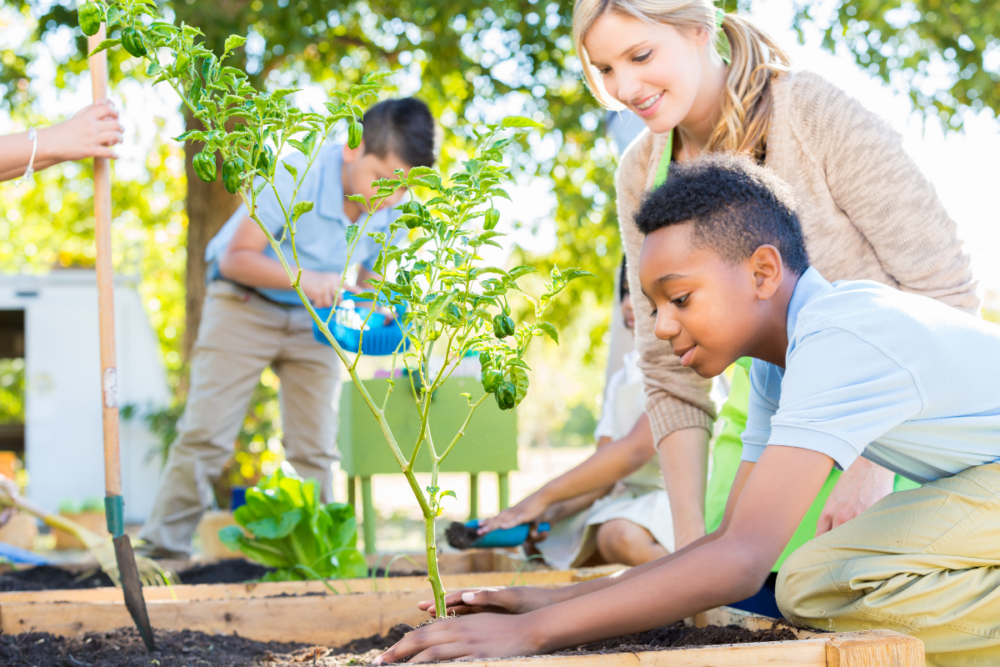
2. Gather Information about One or Two Potential Sustainability Initiatives
Once you have a general understanding of the cultural norms and accepted practices at the school, choose one or two priority initiatives and start to gather information about how to solve them. This information gathering will continue after the sustainability committee is formed.
At this point, however, the initial discovery phase should help establish a base case to start the committee. You can identify one or two reasons to show what the committee can do and why it would help the school. In this phase, you can:
- Discuss with the principal | Share your information-gathering intent with the principal to obtain approval. They will not want to feel like you are snooping around to find problems without first letting them know your good intentions and objectives.
- Observe existing circumstances | Observe systems and habits that impact your focus area. Learn about how they already operate and who is in charge so you can best convey how any sustainable solution would impact and help them.
- Discuss with stakeholders | Meet and discuss with various stakeholders, like one or two teachers you know and parents you know to get their initial perspectives on the topics you want to address. Focus especially on parents that volunteer at the school and/or show up to PTA meetings. They will have the most information and the most influence over potential opportunities for change.
- Chat with maintenance staff | Talk with the custodians or maintenance staff to get their thoughts on what you are thinking about doing. It’s highly likely whatever you want to do will impact their job. And they probably have some useful information to help you find viable solutions as well.
3. Gather Support from School Administration
Before starting a sustainability committee, it is important to gather support from the school administration. This will help ensure that the committee has the necessary resources and authority to make meaningful changes. Here are some steps to take:
- Research school policies: Start by researching the school’s policies related to sustainability. This will help you understand the school’s current approach to sustainability and identify areas where improvements can be made.
- Identify key decision-makers: Identify the key decision-makers in the school administration, such as the principal, assistant principal, and school board members (if applicable to the nature of the committee you’re looking to start). These individuals will be instrumental in supporting the sustainability committee.
- Make a pitch: Once you have identified the key decision-makers, make a pitch for the sustainability committee. Highlight the benefits of starting a committee, such as reducing the school’s environmental impact, saving money on utilities, and providing hands-on learning opportunities for students.
It is important to be prepared with specific ideas and proposals for the sustainability committee. For example, you might suggest starting a composting program, implementing energy-efficient lighting, or organizing a school-wide recycling initiative.
Be sure to emphasize that the sustainability committee will be a collaborative effort, involving parents, students, teachers, and other members of the school community. This will help demonstrate that the committee will have broad support and buy-in from the school community.
My Experience | Where I started to gather information, advocate for sustainability at school, and gather support from administration
My efforts started with the food waste in the cafeteria. When I visited to have lunch with my girls, I was shocked at the volume of food waste in the cafeteria. It was really horrendous. I couldn’t believe how much was tossed. Students threw away food that wasn’t even touched or opened (milk, apples, fruit cups…)!
I started gathering information by talking to just about anyone that would listen and finally ended up talking to the PTA president. I spent the better part of the conversations learning and listening. I asked questions about the cafeteria, recycling, trash, and composting practices at the school.
Through my conversations, I learned that our school composted some food scraps in the cafeteria through a practice led by the garden educator. Also, 5th graders used to help the custodians collect the recycling from classrooms, but that program happened under the beloved old principal. It was one of several programs that got lost in the shuffle during the transition to new leadership.
My friends at the school are awesome. While I gathered information about the food waste dilemma, they supported me and listened to all my curiosities about why things were the way they were. They offered insight and suggestions to help process all the information and help me implement my dream to more responsibly manage the food waste in the school cafeteria.
The PTA president appreciated my enthusiasm but had no clue how to find or implement solutions. These types of matters weren’t in her wheelhouse.
Given the status quo of our communities and systems in this country (like our broken food and waste management systems), many people in leadership positions probably lack insight into sustainable alternatives to typical operating practices. Thus, educating leadership about sustainability is probably a common hurdle many people will face when trying to start sustainability initiatives at schools. That’s not an insult to those in leadership roles, just a reason why people with knowledge and passion for sustainability can be valuable assets to school communities.
Following our discussions, the PTA president encouraged me to email the new permanent principal with all I had learned and all the potential I could see for the school to be more eco-friendly. I emailed the new principal, and we agreed to try to incorporate some of my ideas into the school lunch program.
Of course, I needed help with all the things I wanted to implement, and I surely couldn’t do it alone. All the work I put into the school lunch review and sustainability suggestions proved the viability of a sustainability committee. With the support of our PTA and principal, the sustainability committee was born.

4. Recruit Members for the Sustainability Committee (Parents and School Employees)
Starting a sustainability committee at your child’s school requires a team of dedicated individuals who share a passion for the environment. Not only is it too much work for one person to take on themselves, but such changes also require buy-in from a larger group who believe in the mission and are willing to put in the work. It’s time to find the people who want to be involved to support your goals.
The following are some ways to recruit members for the committee:
- Word of mouth | Make announcements at school events and meetings to let parents, teachers, and students know about the committee and its mission. PTA meetings and school communications are great ways to let people know about the committee and ask for volunteers.
- Tables at school events | Host an informational table at school events when parents and caregivers will be present. Special events like concerts, school fairs, and other events could be great opportunities to answer questions for prospective volunteers and connect more directly with them.
- Email blasts | Send out emails to parents and teachers to inform them about the committee and invite them to join. Emails could come from the principal, the PTA, or even homeroom parents, depending on which communication methods are most effective at your school.
- Classroom visits | Visit classrooms and talk to students about the committee and how they can get involved if you’re planning to involve students. Depending on the age of the students, the sustainability committee may be more parent-driven. But students can provide suggestions for initiatives and even encourage their parents to get involved. 🙂
- Social media | Many schools, and even PTA organizations, have social media accounts that are great methods of communication with parents and the community. Use social media platforms to reach out to parents, students, and teachers and encourage them to volunteer to be on the committee and help out with specific events.
It’s important to have a diverse group of members with different backgrounds and perspectives. Parents will likely provide the most help, but you’ll need teachers or other school employees to help with or be liaisons for many of the programs. A mix of parents, teachers, and other school employees will likely be the best recipe for success. Consider reaching out to the following groups:
- Parents | Encourage parents to join the committee to provide a different perspective and to help with fundraising and outreach efforts.
- Teachers | Involve teachers in the committee to help integrate sustainability into the curriculum and to provide insight into school policies and procedures.
- School Staff | Many environmental issues will involve non-teacher staff, especially building management and maintenance personnel. Reach out to these teams to see if they are interested in volunteering or at least being available for input on various events and plans.
- Students | If they are old enough, engage students in the committee to help them learn about sustainability and to give them a voice in decisions that affect their school. Younger students can share ideas and help their parents while older students may be able to volunteer independently and lead certain initiatives.
- Community members | Reach out to local businesses, organizations, and community members who are passionate about sustainability and could provide resources and support for the committee. They may be able to provide information, tools, funding, and other resources to host events. They might be able to provide snacks during committee events or spread the word about events that involve the broader community. And they may have employees who want to help organize or volunteer for events hosted by the school sustainability committee.
My Experience | How I found the people for the school sustainability committee
We have a back-to-school night each year. Each committee of the PTA and any other organizations at the school sets up tables to connect (and hopefully recruit) parents, teachers, and administrators to help them achieve their goals.
In 2019, I set up a table for the new sustainability committee and got several people signed up to join us. Also, our PTA leadership really helps spread the word about our initiatives and sends people our way when they want to join.
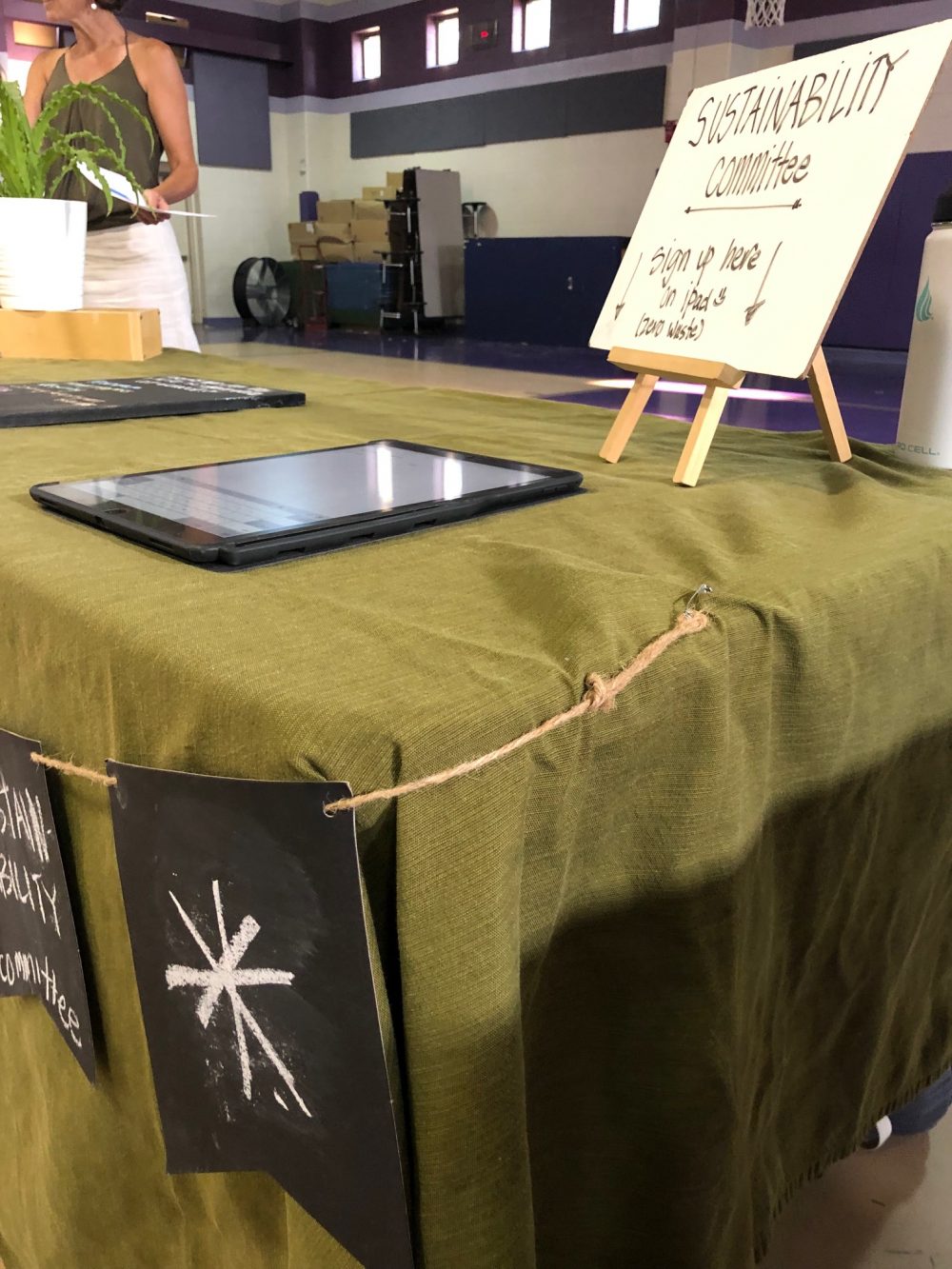
We did not have any teachers or school employees sign up that night to join us, but we do have teachers and others at the school who act as advocates and liaisons and even help run certain programs. More on that below.
5. Structure the School Sustainability Committee For Success
Many hands make light work; all the helpful parents will make implementing sustainability programs easier. But you’ll also need clear communication about your ideas and their impacts as well as buy-in and approval from the school administration and others at the school whose work will be impacted by the changes.
Fortunately, sustainable living prioritizes using resources already available, so you may not need a significant financial budget. But you’ll probably need some amount of funding for various things during the year.
As you set up the committee, be sure to:
- Choose a leader or co-leaders | To get anything done, someone has to make decisions, so be sure to have a leader or co-leaders established for the committee. If you’re the one pushing for the committee, you might be the best person for this job.
- Assign a communication coordinator | Put one person in charge of communication. They can send emails to the committee, emails to parents-at-large, and correspond with teachers and school leaders on behalf of the committee. This could also include communication with the community if activities or programs engage people outside of the school.
- Hold space for open dialogue | Create space and expectations for discussing sustainability committee ideas with school administrators and school employees, especially those whose jobs are impacted by your programs. Be ready to set aside time to get their input in a meaningful way and respect their perspectives, even if they don’t always align with the committee’s goals.
- Find teacher advocates | Engage at least one or two teachers who can represent the teachers and advocate for sustainability initiatives at staff meetings and other teacher forums. This is really important
- Establish funding expectations | Set expectations with the PTA or the school about how to request funding and what amount of funding might be available throughout the year so the committee can plan programs accordingly.
My Experience | How I structured the school sustainability committee
We don’t have scheduled meetings for our sustainability committee. Most of our communication is via email, and I usually drive the agenda and plans for the year (all of which are ideas that the committee has been floating around). I also send out communications to let people know when something gets approved by leadership. Typically, the PTA president takes our ideas and proposals to school leaders who then make a decision about whether or not we can proceed.
Once we get approval for the desired program, I ask for the committee’s support. Those who can step up take on various tasks to get the project done! I’ve got about 20 people on the email list, and I’d say about 5-7 of them actively participate.
We also have a teacher liaison, someone who I knew was a steward of the planet. They help get answers to questions, communicate our initiatives at staff meetings, and give us suggestions on what other projects we can do.
We don’t have a formal budget. We request funds from the PTA if we need them, and they allocate them to us if approved. Each year, we hold a seasonal yard sale and the funds we generate from that go back to the PTA. Our contribution to the PTA budget helps support requests from it throughout the year too.
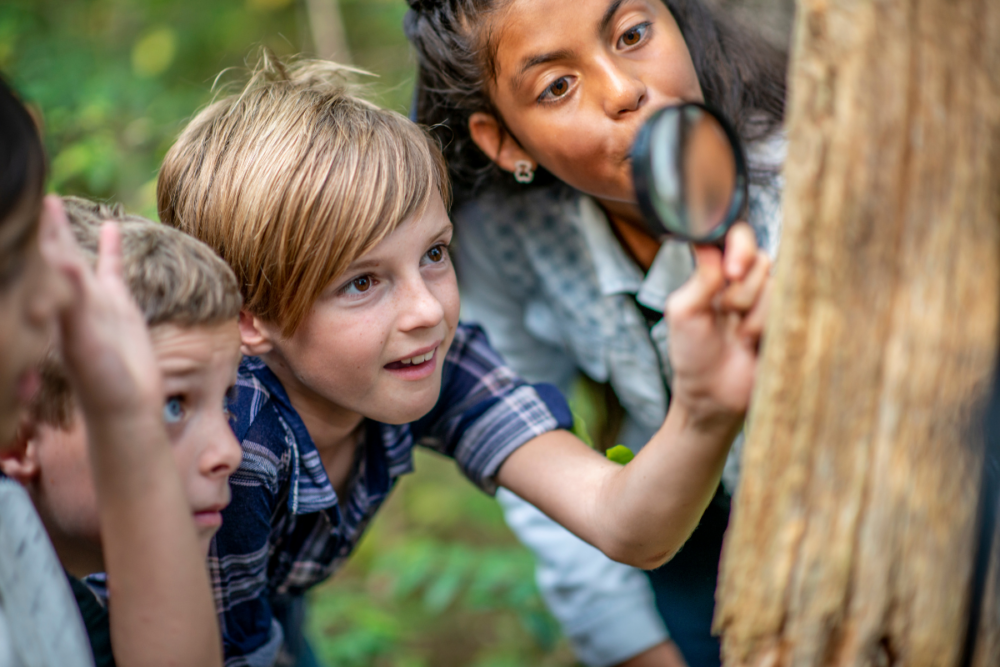
6. Be Prepared For Slow Progress on Some Programs
The more a program impacts people at the school, the more likely it could be a slow process to get approval. Many projects take quite a while to plan, approve, and execute as we work through consensus-building and proper approval. If programs have little impact or require few resources from the school, you’ll likely be able to execute these in a more expedited time frame.
My Experience | Expected timelines in our experience implementing sustainability initiatives
For us, it takes what seems like forever to implement plans that require school staff involvement. In the case of the lunch compost program, I had to observe what was happening in the cafeteria during lunchtime, consider different solutions we could implement, and talk to the staff in the cafeteria, the custodians, and the cafeteria lead. This was effectively a second information-gathering exercise after initially gathering enough information to request investing potential solutions.
With input from all the important stakeholders, I proposed an idea to the principal. After they accepted my proposal, I spent a week in the cafeteria with volunteers to help the kids and staff understand the new plan to separate compostable items. Ms. Kate, the school garden director, reinforced the separation of items in her garden class. It took a good while to get it going, not perfectly but just going!
Programs that don’t involve school staff can move faster. For example, we host an annual yard sale and purchase reusable utensils and tableware for classroom parties (more on these programs below).
We can get the annual yard sale up and running quickly because we only use the school grounds and a few tables from the PTA. The committee did the bulk of the work outside of school staff and resources. We bought the reusable tableware with the PTA funds and our teacher liaison mentions it at staff meetings as it applies

Sustainability Program Ideas for a School Sustainability Committee
There are tons of ideas for ways that sustainability committees can help schools be more sustainable both in their practices and their educational matters. Here are a few examples of programs to consider, but the options are endless and will also depend on the unique circumstances of your child’s school.
- Compost programs
- Garden or grow-your-own food programs
- Reusable products
- Supply swaps
- Yard sales
- Recycling programs (including hard-to-recycle items like batteries, candy wrappers, and more)
- Educational materials or workbooks to incorporate sustainability into classroom activities
Download a FREE Digital Workbook
We’ve created a printable PDF as a resource to help you start your own sustainability committee at your child’s school! It includes questions to help you start thinking about how to start a sustainability committee, plus an extended list of sustainability program ideas that might work for your school. To download the list, drop your email address in the sign-up form below. After confirming your email address, you’ll receive the printable resource in just a few minutes.
As you plan ideas, start small with a project or two that are easy to manage or maintain can feel like quick wins. Be mindful that teachers, school staff, and many parents already have full plates.
- Expensive or time-consuming proposals will have a hard time passing approval and getting buy-in.
- Turnover happens for teachers and parents; ensure ongoing programs have sufficient support for the foreseeable future so they don’t become a burden on staff or parents.
- It’s better to implement a program in small steps with success and achieve a “better” alternative than trying to accomplish something massive in search of perfection.
- Programs with smaller time and financial commitments can show success with just a few people and limited resources to help get others on board to help in the future.
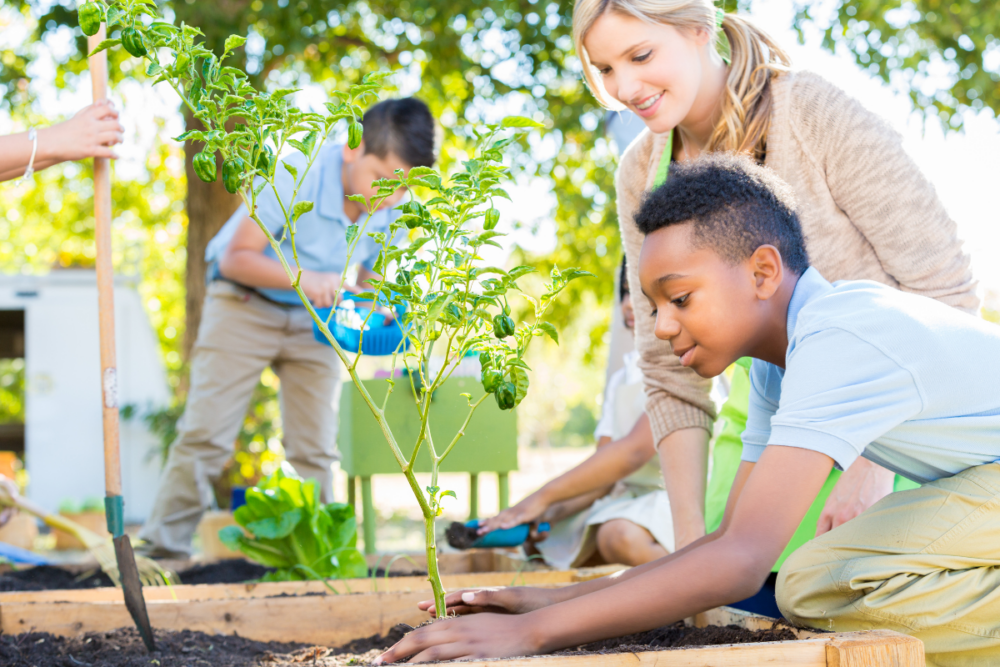
Sustainability programs and events we facilitate at our elementary school
Our committee is focused on sustainability initiatives at the school and hosting events that encourage eco-friendly habits at home. Here are a few programs we have started in the last few years.
Composting in the cafeteria
With help from our garden educator, Ms. Kate, students compost uncooked fruits and vegetables at lunch. Instead of trying to compost everything, we focus on certain types of items that are easy for kids to separate and also carry a lower risk of causing issues in our school compost bins.
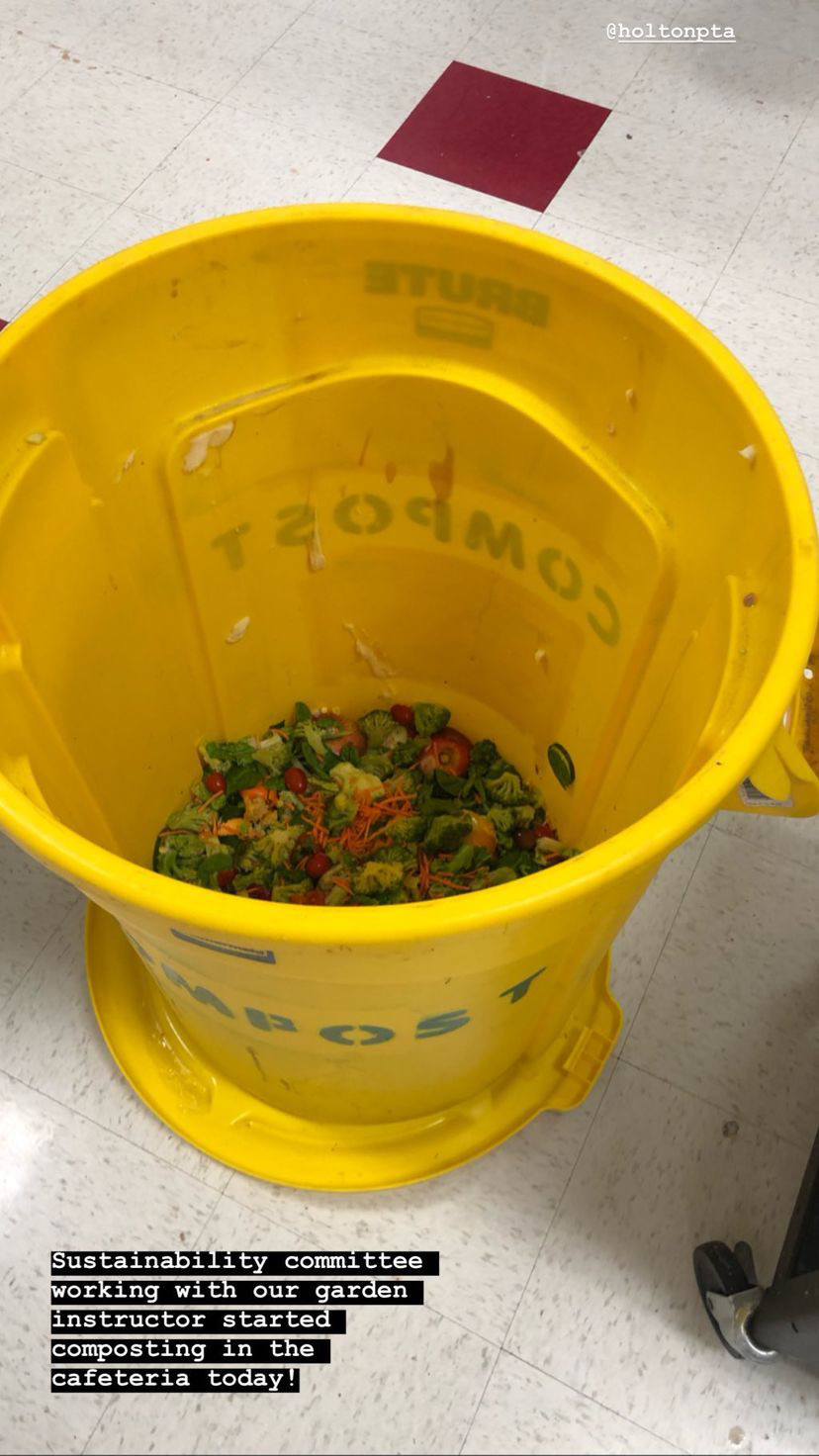
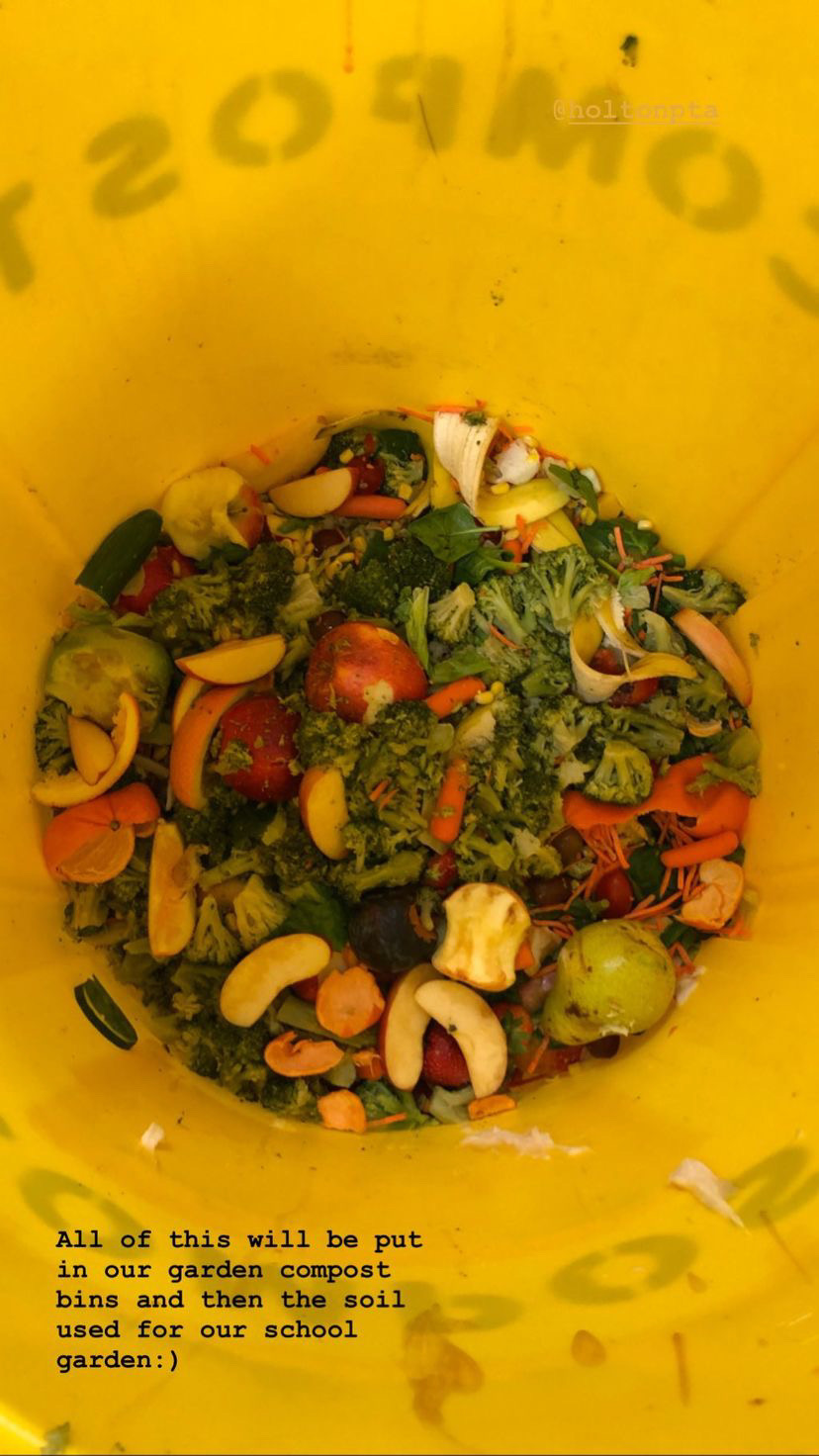
After lunch, Ms. Kate picks up and tosses the food scraps in our school compost bins. Together, we created a game she could play with the students during garden class to make sure they know what items go in the compost bin and understand the importance of composting.
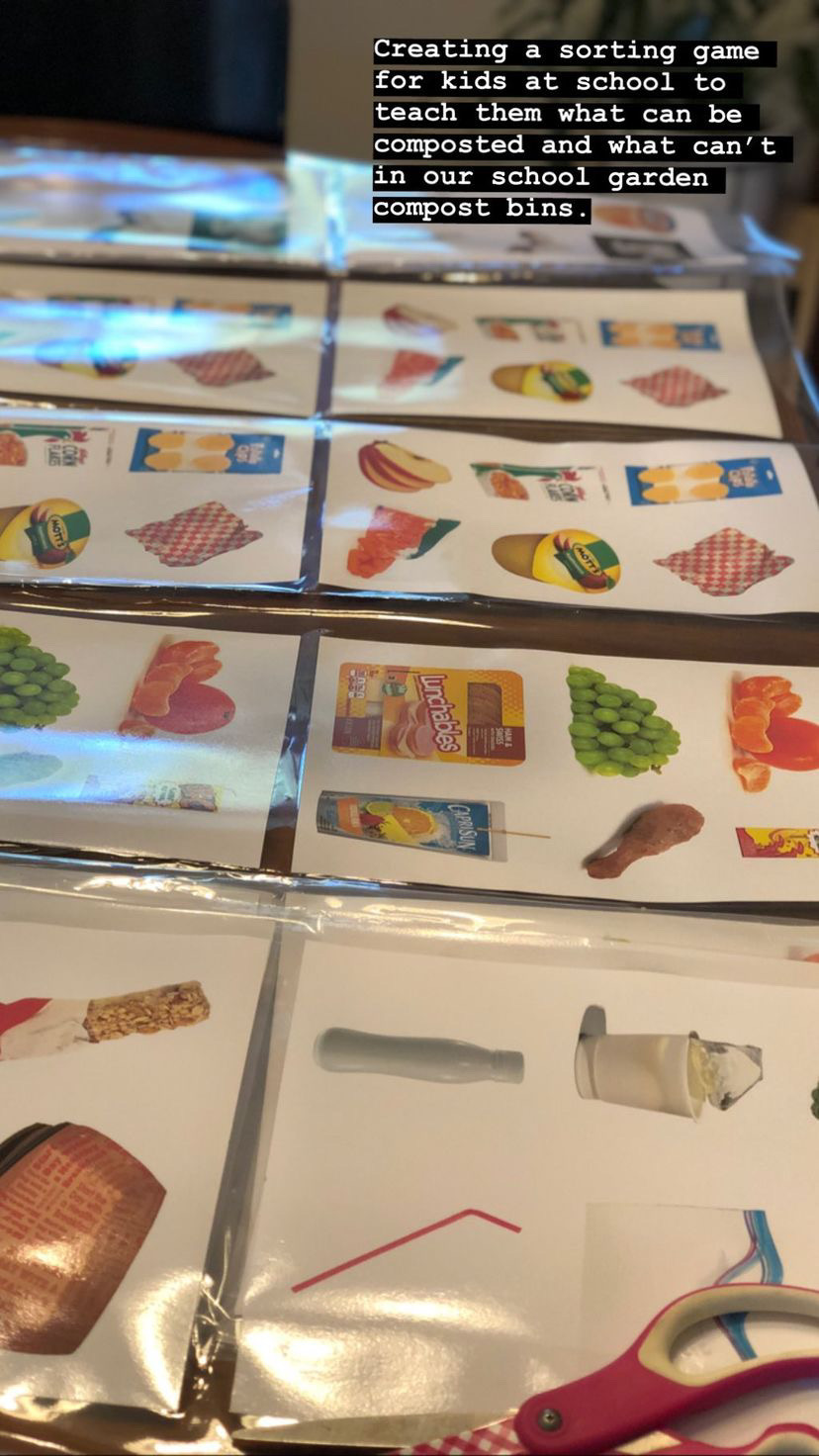
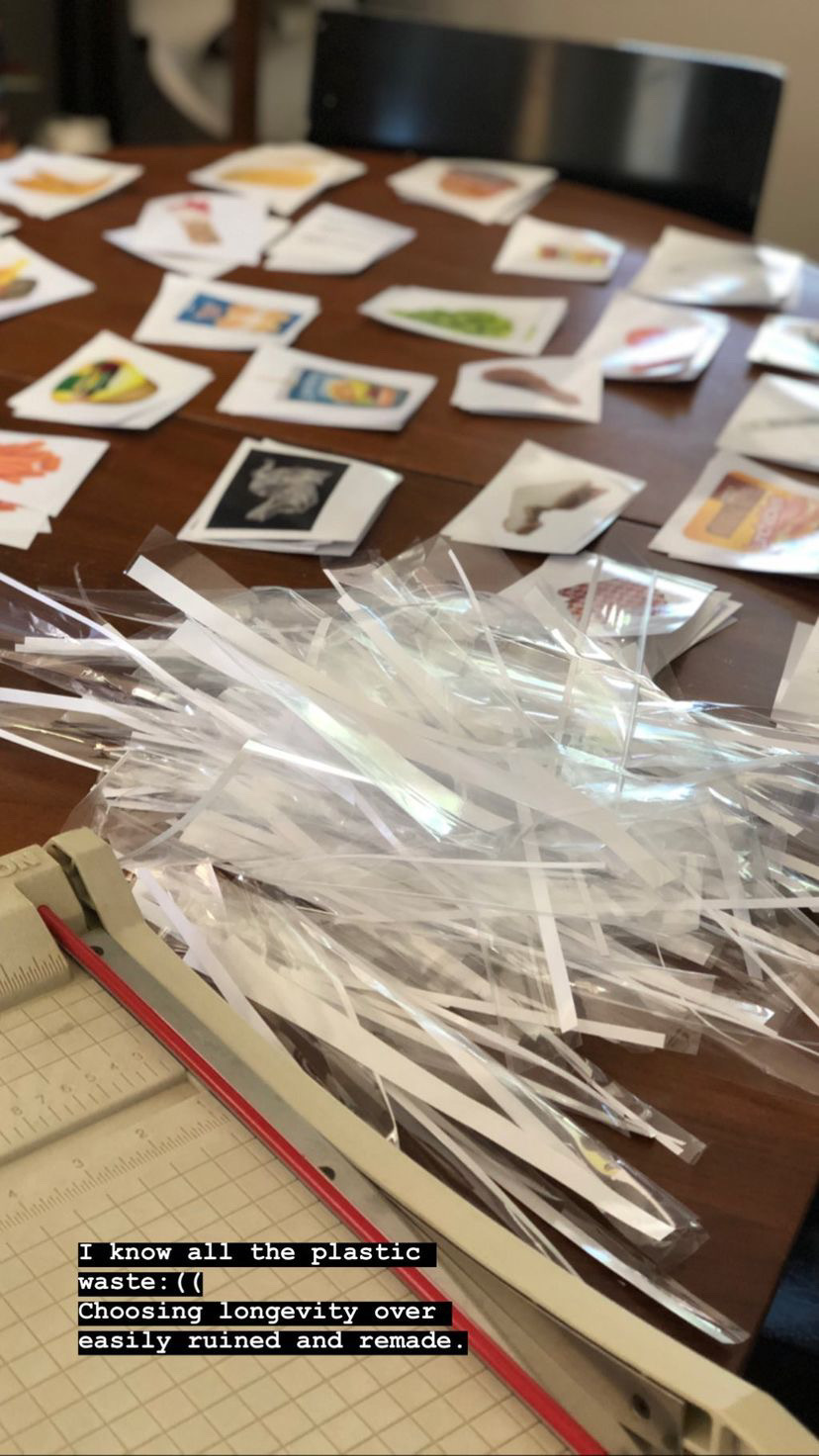
Community table in the cafeteria
So many kids don’t eat everything in their lunches. We implemented a community table (or share table) where students can leave packaged or unused items they don’t plan to eat. Other students can take them. This really cuts down on the amount of perfectly good food being tossed – especially the milk!
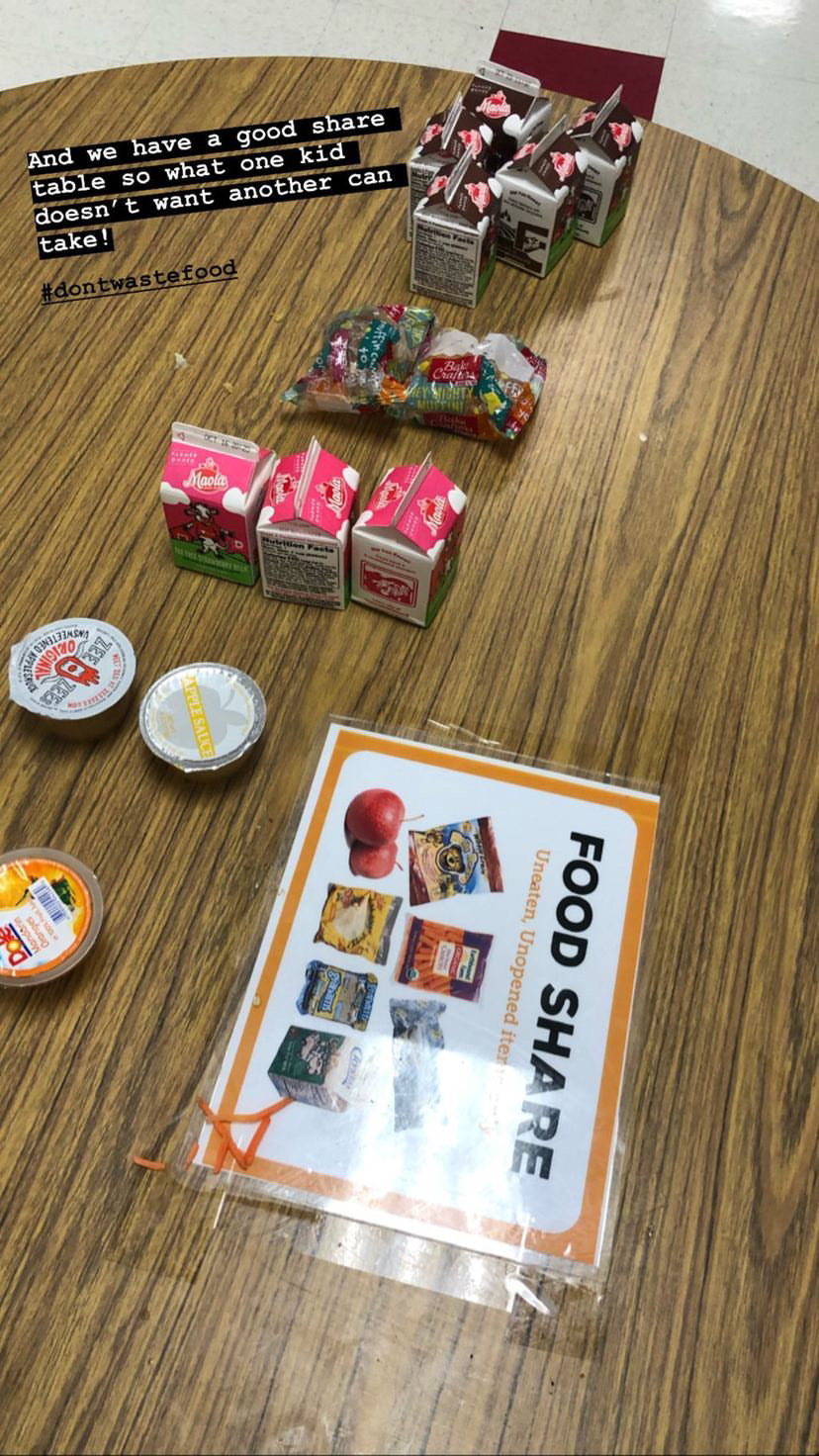
Separated liquids from solids
A system was created to dump liquids into a bin with a strainer. This catches those pesky straws and allows cafeteria staff to dump liquids in the sink instead of the trash bins (which were so heavy and leaky with liquids). The custodians spearheaded this initiative, and it went along perfectly with the composting program and community table. For all these programs, kids need to examine their food waste and be sure to sort it into the right place – liquid bin, trash, compost, and community table.
Reusable plates, cups, and utensils for classroom events
The PTA approved the purchase of 150 sets of reusable tableware. The Kindergarten classes host a Thanksgiving feast each year. This prompted the purchase to replace all those disposables with reusables. We store the sets in the teacher liaisons’ classroom and any teacher or parent can check them out for parties in their classrooms or anytime they are needed. Students could even use them for birthday parties at home.
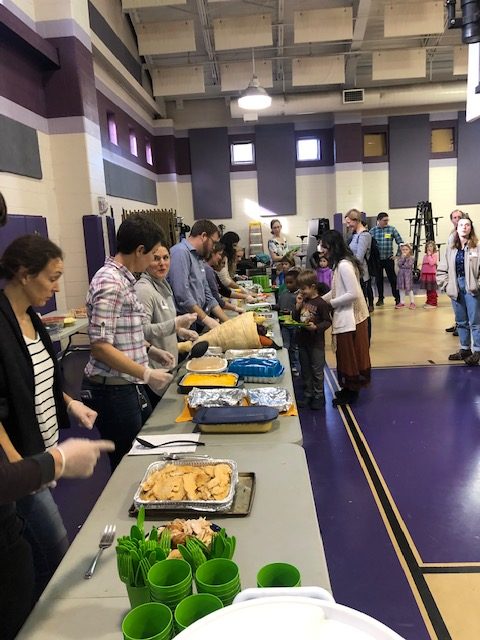

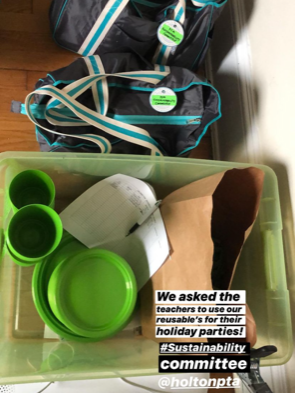
Semi-annual yard sale
We host annual Spring and Fall Children’s yard sales to encourage second-hand buying. All of the items are donated by school families or the community. We sell all sorts of items like clothes, cribs, child and baby items, toys, and more.
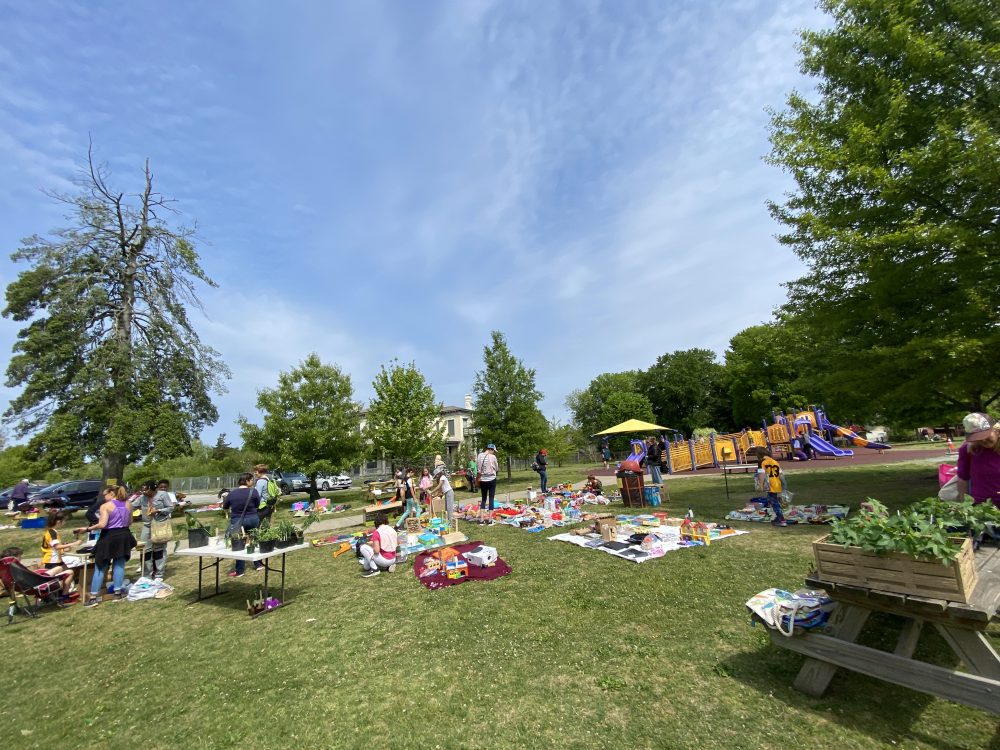
Here are a few initiatives we hope to start.
Terracycle offers recycling programs for hard-to-recycle items, including many that are common for children, like applesauce pouches, juice boxes, and many oral care products like toothpaste containers, lids, toothbrushes, mouthwash bottles, floss containers, etc… We would like to put clearly labeled boxes in the cafeteria where anyone can drop items.
End-of-year supply clean-out boxes for teachers
It was mind-boggling to see teachers toss perfectly good supplies at the end of the year!!! Through this program, teachers can put any school supplies they no longer want but that still have plenty of life left in them want in the supply boxes. Then we allow the school staff, teachers, and parents to shop for back-to-school. Alternatively, the school could donate the supplies to school donation programs if students in their school don’t need them.
Shared supply cabinets
Much like in our homes, there seem to be multiple versions of supplies in closets, drawers, and desks. We intend to organize them and take inventory and possibly create one communal supply cabinet so supplies are not languishing unused around the school.
Leftover supplies that teachers cleanout can be put back in the shared supply closets. Then we are not asking for new supplies from families when there are excess supplies in other classrooms or stashes. This circular and interconnected system of supplies helps ensure nothing in perfectly good condition gets wasted or trashed.
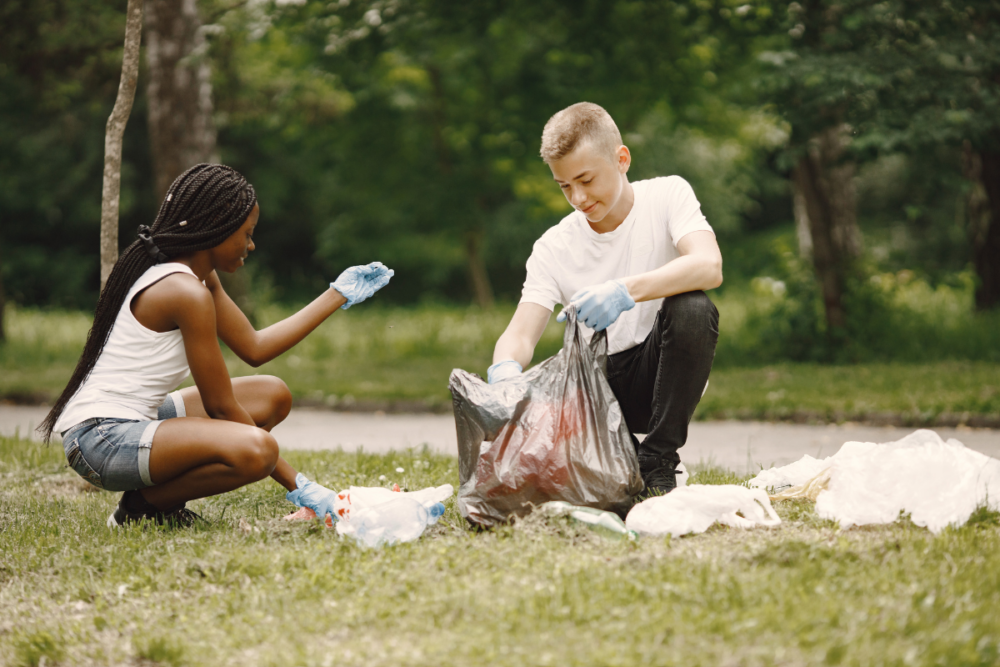
Get Students Involved
Strive to work with the students and have them take responsibility for the initiatives when possible. In many cases, programs are more successful and impactful when the students buy in and have the programs in their hands. It’s also a great opportunity for kids to practice community building and collaboration.
Each initiative will have different ways for students to participate and lead, depending on the program and the age of the students. But in many cases, there are some ways students can help.
For sustainability programs, students can:
- Oversee them (like helping other students sort their lunch scraps properly)
- Encourage their friends to join
- Donate their items or their time to the mission
- Be a helping hand for a program led by an adult
Roots and Shoots is a non-profit with a mission to empower young people to affect positive changes in their communities. Check out their 4-step framework for engaging young students in community programs to get ideas about how to incorporate the students into the programs led by the sustainability committee. Cafeteria Culture was the inspiration for our cafeteria sorting program. Their program involved A LOT of student leadership and coordination with teachers. Although ours is nowhere near their program’s reach, it was the model that sparked the fire for me.
My Experience | How students help with our sustainability programs
Ms. Kate has a program for 4th and 5th graders (Habitat Heroes) to help pick up trash around the school. This didn’t start through the committee but we brainstormed together to design the program. Students help their peers sort food waste in the cafeteria. They donate some of their toys and clothes to our yard sale. Hopefully, we can continue to get the students involved even more.

Get Teachers and Staff Involved
It’s really helpful to have a teacher or two engaged with the committee, ideally, ones that have a passion for sustainability. They provide lots of insight into how things work within the school on a day-to-day basis and who really has influence over change. They also participate in staff meetings and professional development activities and can be advocates for the committee’s initiatives in these spaces.
Not all teachers will be particularly interested in or engaged in the work of the sustainability committee. Teachers have so much on their plates already, so it’s hard to take on even more. But one or two teacher or staff advocates are really helpful.
How teachers help with our sustainability committee activities
The teachers and administrators who are advocates of sustainability in their personal lives support our sustainability actions and definitely are on board with our mission. But it’s unclear how the rest of the teachers feel about our work.
Some seem like they really don’t care and help implement programs so long as they are of little to no effort on their end. I understand this challenge given their workload already, so we do our best not to ask too much of the teachers and let them volunteer only when they’re really interested.
Consider Getting the Community Involved
Once the committee is up and running, you can also reach out to other community organizations to gain additional support and resources for your efforts. However, this can be a challenge and make progress even slower than it already might be (as mentioned above). It’s easiest to start by focusing on what the school can do within its own community and expand outside the school if and when there is sufficient support for the programs internally.
My Experience | How we engage the community in our sustainability initiatives
It’s hard enough to get things rolling at the school. It’s very slow, as I mentioned above. Thus, we haven’t really stepped outside of the school community yet to the broader community. Some families do use the school compost bins to drop off their home food scraps and a lot of pumpkins from the community go into our school bins too! We had a previous parent collect coffee grinds from the neighborhood coffee shop for the school compost bins as well, but as kids leave the school, so do the parents. I would love more community engagement; add it to the list!
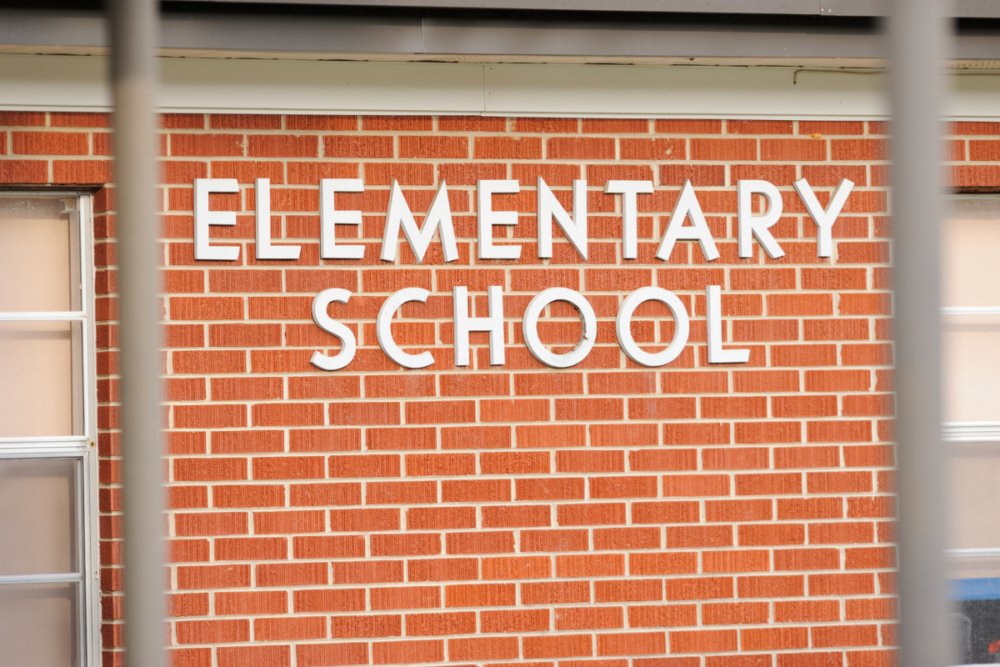
Additional Steps for a More Formal Sustainability Committee Initiative
In our work, the sustainability committee was fairly informal and operated with limited funding from the school or required involvement from school leadership. This allows us to keep the structure and reporting fairly informal as well.
However, if you are looking to develop a more formal sustainability committee aligned with higher-level administration or the school board, you might need a more formal, long-term plan and metrics by which to measure success and accountability.
Develop a Longer-Term Sustainability Plan (Optional)
The importance of this step depends on the formality and nature of your sustainability committee. If the group is set to host periodic events or work more informally with the administration, you might not need a formal, long-term agenda. But if the green team is designed as part of a larger school board initiative, for example, this step will be important to set expectations and establish a baseline for measuring success.
Once the green team has been formed and the school has committed to sustainability, a sustainability plan helps maintain progress and keeps everyone on the same page. The plan should outline the school’s sustainability goals, strategies for achieving those goals, and a timeline for implementing those strategies.
It helps if the sustainability committee conducts an environmental audit to identify areas where the school can improve its sustainability practices. This audit should include an assessment of the school’s energy and water usage, waste management practices, and transportation policies, for example.
This step can be done formally with the help of a consultant or more informally, as I did, gathering information from school personnel, parents, and community members about programs like the food waste initiative in the cafeteria. The degree of formality under which a plan is developed will depend on the nature of the committee you’re looking to build.
Based on the results of the audit or initial research, the green team can then develop a set of sustainability goals for the school. These goals should be specific, measurable, and achievable within a set timeframe, particularly if results are being reported to a higher level of administration. For example, the school might set a goal to reduce its energy usage by 20% within the next year.
Next, the green team should develop a set of strategies for achieving these goals. These strategies might include implementing energy-efficient lighting, installing water-saving fixtures, or encouraging students and staff to carpool or use public transportation. The green team should prioritize these strategies based on their potential impact and feasibility.
For our school, food waste in the cafeteria felt like the most impactful and achievable starting point and one about which I was the most passionate. This made it a good starting point for us. But the best place to begin making changes will depend on your school and its particular needs.
Finally, the green team should develop a timeline for implementing these strategies. This timeline should include specific milestones and deadlines for each strategy, as well as a plan for monitoring and evaluating progress toward the school’s sustainability goals if you’re reporting to an administrative body.
Monitor Progress and Evaluate Success (Optional)
Once the sustainability committee has been established and initiatives have been implemented, it is important to monitor the progress and evaluate the success of the sustainability program regularly, particularly if it’s a formal initiative. This will help the committee to determine whether the initiatives are effective and whether they need to be modified or improved.
One way to monitor progress is to establish key performance indicators (KPIs) for the sustainability program. These KPIs should be specific, measurable, and relevant to the sustainability goals of the school. For example, KPIs could include the amount of waste diverted from landfills, the reduction in energy consumption, or the number of students participating in sustainability initiatives.
Regular reporting on the KPIs can help the committee to identify areas where the sustainability program is succeeding and areas where improvement is needed. This reporting can be done through regular meetings, newsletters, or other communication channels.
Evaluating the success of the sustainability program is also important. This can be done through surveys, feedback forms, or other evaluation tools. The feedback received from students, teachers, and parents can help the committee to understand the impact of the sustainability program and identify areas for improvement.
It is important to remember that sustainability is an ongoing process, and the sustainability committee should be prepared to make changes and improvements as needed. By monitoring progress and evaluating success, the committee can ensure that the sustainability program continues to make a positive impact on the school and the environment.
Celebrate Achievements and Encourage Ongoing Participation
It’s important to celebrate the achievements of your sustainability committee and encourage ongoing participation. This will help keep the momentum going and motivate everyone to continue making positive changes.
Celebrations don’t have to be extravagant, but it’s often appreciated and useful to share the accomplishments with others in the school community. It feels good for those who worked hard to make changes and it’s a great way to recruit new advocates and volunteers.
One way to celebrate achievements is to publicly recognize and reward the efforts of the committee and individual members. This could be through certificates, awards, or even a special event. It’s important to make everyone feel valued and appreciated for their contributions.
Another way to encourage ongoing participation is to regularly communicate the progress of the committee and the impact of their actions. This could be through newsletters, social media updates, or even announcements at school assemblies. By sharing the successes and challenges, everyone can stay informed and motivated to keep working towards sustainability goals.
Finally, it’s important to keep setting new goals and challenges for the committee to work towards. This will help keep everyone engaged and motivated to continue making positive changes. It’s important to make sure the goals are realistic, achievable, and aligned with the overall vision of the committee and the school.
What did we miss about starting a sustainability committee at your child’s school?
What else did we miss? Have you started a green team at your child’s school or helped a group bring more sustainability initiatives to the school community? We’d love to know how you did it. What worked and what were your biggest obstacles? Let us know in the comments!
Don’t Forget! Download a FREE Digital Workbook
And if you’re interested in starting your own sustainability committee, don’t forget to download our workbook to help you through the process!
About The Author

Rupa Singh
Rupa Singh is an ex-social entrepreneur and mom of three kids connecting them to their South Asian (Indian) roots + sustainability. Organizational wife to an altruistic architect. Advocate for low waste + thoughtful consumption. Continually unlearning + learning. Her bullet journal + audiobooks + morning ritual feed her spirit.


